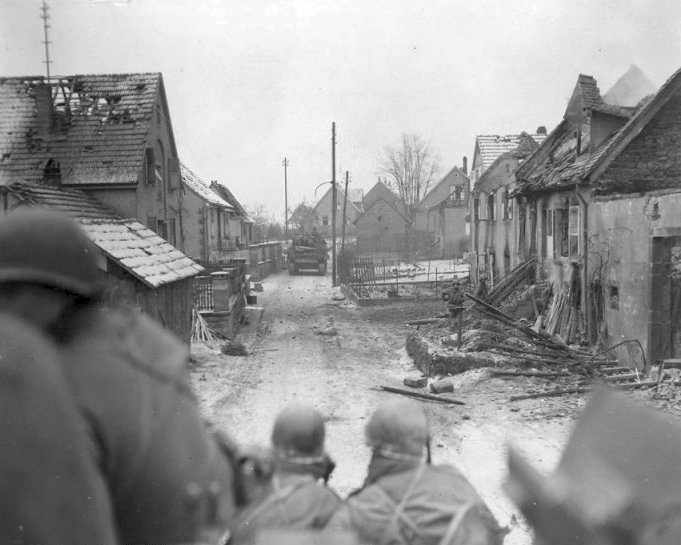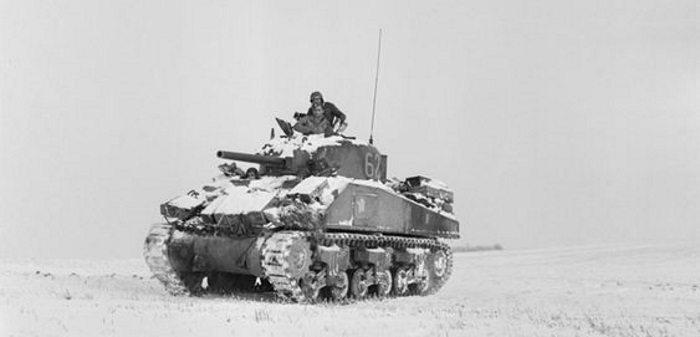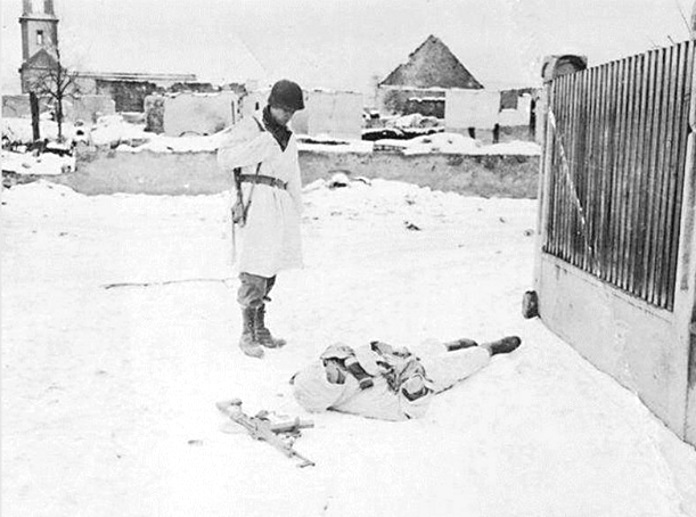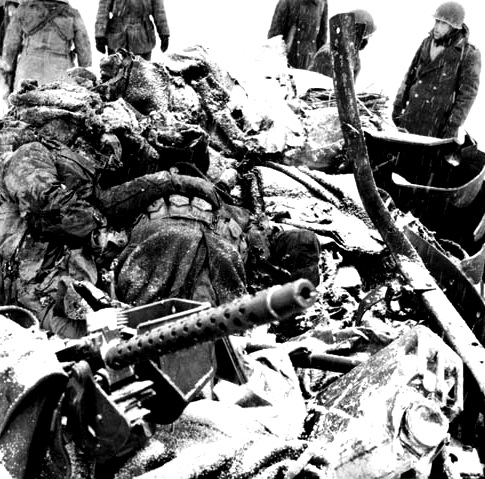The platoon leader and his runner moved constantly back and forth in the lead squad, sometimes with the squad leader and his scouts, sometimes in the rear of the squad. The men of the platoon did an excellent job of teamwork and control all this time and good progress was made. About 0400-0430 the lead scout came out among the trees along the edge of a large field. The squad leader immediately gave the signal to halt and waited for the platoon leader to join him. The two then made their way up to the scout, who was kneeling silently beside a tree looking out into a white gloom that gave no indication of definite size, just simply a feeling of emptiness and vastness. The advance squad was brought up and deployed on the edge of the woods.
Because of the poor visibility, flank men were warned to remain silent and to listen for any sounds of a possible enemy. One man was then sent cautiously out into the gloom of the field as forwarding security. He took up a position about 50 yards away from the trees, where he was already lost to view. A second man, going forward to recon, returned to report that there was no enemy to the immediate front in the field. This report was received just in time to be given to Capt Powell, who had come forward to learn the reason for the halt. He approved the measures which had been taken so far.
The other two squads of the 3rd Platoon were brought up at this time and deployed on a long line among the trees and bushes, extending the security still farther to the flanks. While this deployment was in progress, the company commander and his platoon leader made a brief reconnaissance. The result of this reconnaissance was an agreement that the platoon had emerged on the southern edge of the Colmar Forest a little east of the point which had been intended. A blob of darkness that was a little deeper than the rest of the night in the southwest was identified as the Rothleible Woods. To the west, from beyond the woods, came sounds of a battle, which was taken as the struggle by 1/7 troops for the town of Qstheim. The firing in this sector was sporadic, with lulls, stray shots, and occasional fierce outbursts.
Maj Jack M. Duncan, commanding the battalion, arrived and he and Capt Powell held a conference there on the edge of the woods. Someone provided a blanket, and with their heads under this light-concealing cover, the two commanders got out a flashlight and consulted their maps. A phase line ran through the center of the field facing them, and it was decided to hold at the edge of the woods. The 2nd Plat of Easy Co, under the command of Lt Willis B. Conklin, moved up meanwhile and took ever control of the right flank of the company. In the 3rd Plat, the squad leaders and platoon leader made frequent inspections along the line of men spread among the trees and bushes in the snow. Their progress to this point had been so simple and easy in its unopposed advance that some few among these men, despite the sounds of conflict in Osthelm to the west of them, were inclined to relax and give in to the feeling of tiredness and numbing cold which had by this time begun to grip them all. Such men dozed; and so their leaders had to keep moving among the positions, warning the lazy and assuring themselves as well that the wakeful remained alert.
Some minutes after 0600, Capt Powell contacted the platoon leader of the 3rd Plat and ordered him to move his platoon about 250 yards to the west, to where a corner of forest out toward the south and the Rothleible Woods. It had been determined earlier, in the conferences under the blanket, that this corner or point of woods provided the shortest route across the open plain into the other tree belt, a distance of about 450 yards over the snowy tableland. The platoon was told to tie in with Lt Conklin’s platoon for a three-platoon attack across the field. Each platoon was to have two squads on a skirmish line, with the right flank of the 3rd Plat guiding on, and extending, the left flank of Lt Conklin’s 2nd Plat. The Line of Departure was to be the edge of the woods jump-off time, 0630. The time interval allowed the 3rd Plat to gather in its security from the front and the left flank and then to move to the Line of Departure proved too short. Some difficulty was experienced also in contacting Lt Conklin’s platoon, which had been warned earlier than the 3rd and so had moved out already to the LD. By the time the 3rd Plat pulled into position to the left of the guide platoon, it was already past H-Hour. The 2nd Plat was not ready either, however, one of its squads having been on the receiving end of an artillery concentration some minutes before.
Capt Powell, impatient at the delay, used this opportunity to inform the 3rd Plat leader that the rest of the battalion was following the two attack platoons across the open field and that if the platoons were fired upon they were to go right into the assault – that the support platoon of Easy Co and the companies behind Easy Co would be following right in, as a sort of a second wave. This word was passed to the squad leaders and their men as they fanned out into formation in the deep snow just outside the edge of the woods.
Formation for the attack consisted of two squads on a skirmish line, the right squad being in contact with the left-most man of a similar line formed by the 2nd Plat. The remaining rifle squad in the 3rd Plat was placed just behind the rifle squad on the right, which it was to follow at 20 yards distance. The section of light machine guns was placed on the very heels of the left squad, with instructions to the section leader that he was to swing up on line to the left of this squad, set up his guns, and fire to the front, the left front, and the left flank if the platoon hit opposition. It was 0650 by the watch of the 3rd Plat leader when the quiet word came from the right that the 2nd Plat was moving out. His own platoon moved out also. The men were trudging through deep, powdery dry snow which had a frozen crust. In the misty gloom of the night up ahead, they could make out dimly, somewhat to their right, a dark blob of woods, their objective.




















